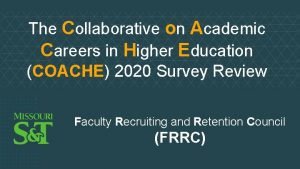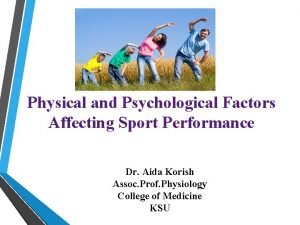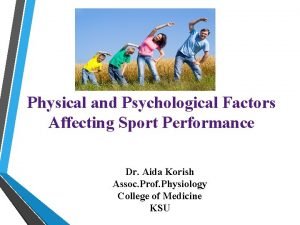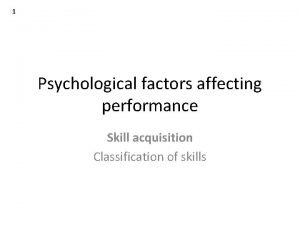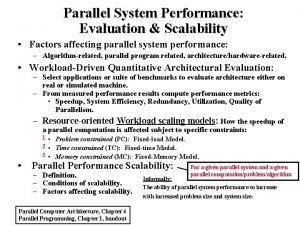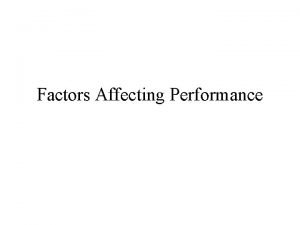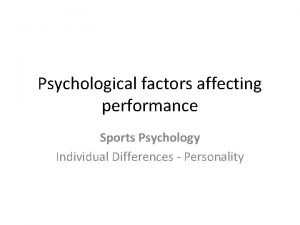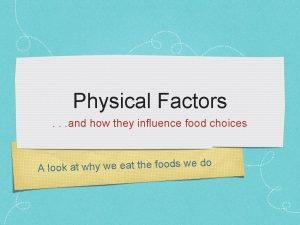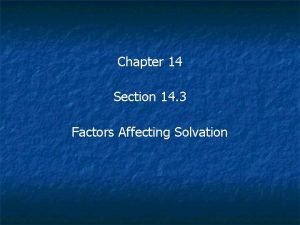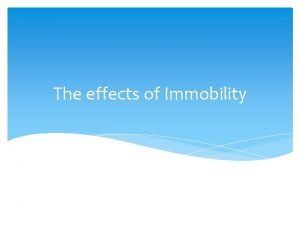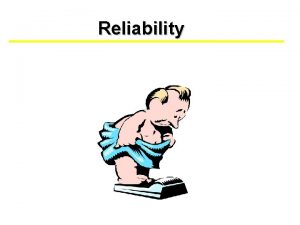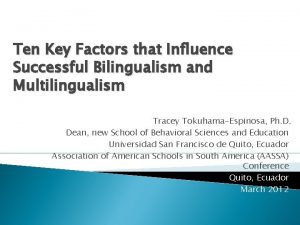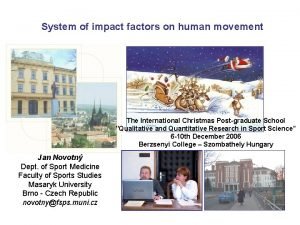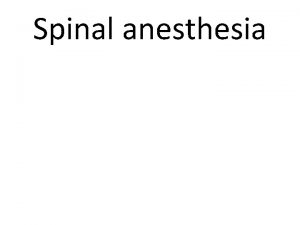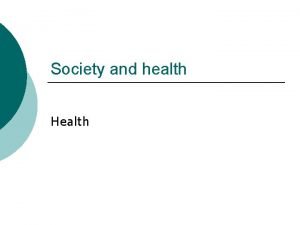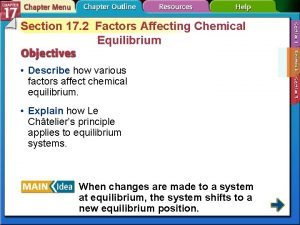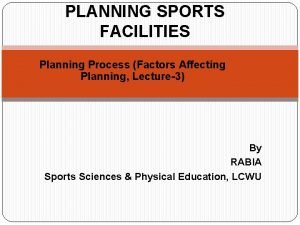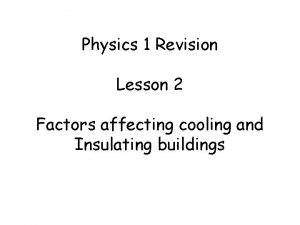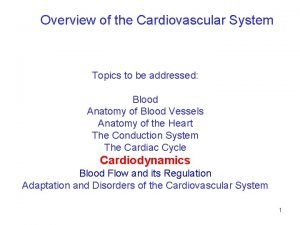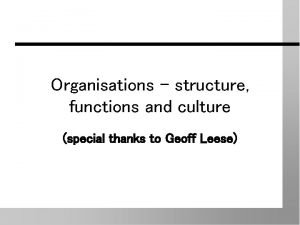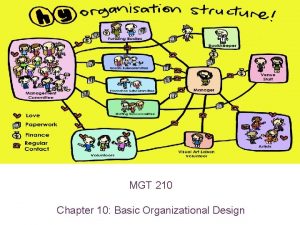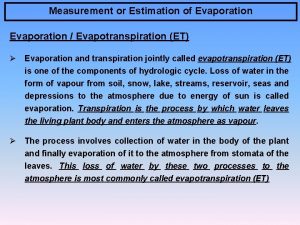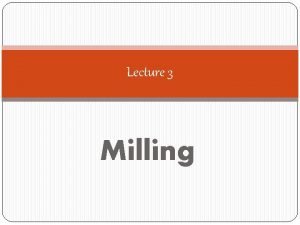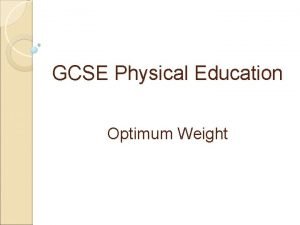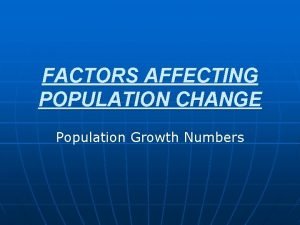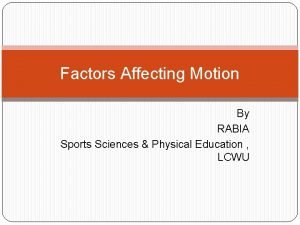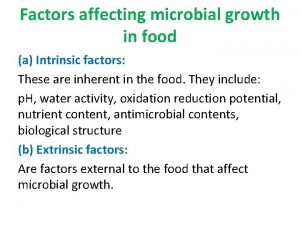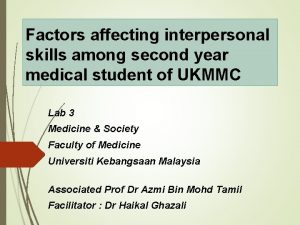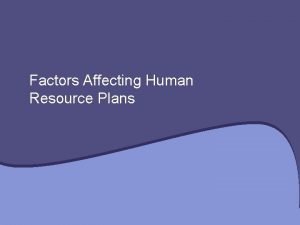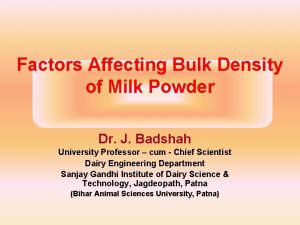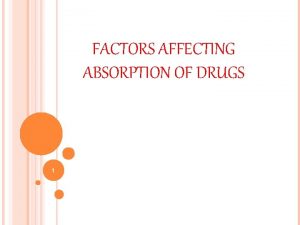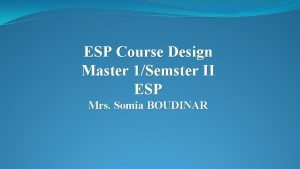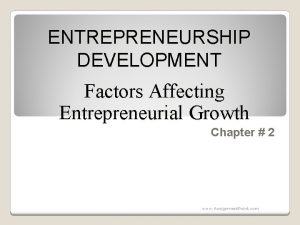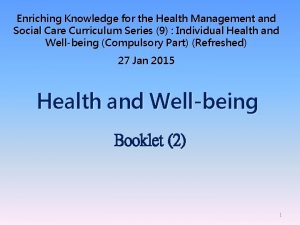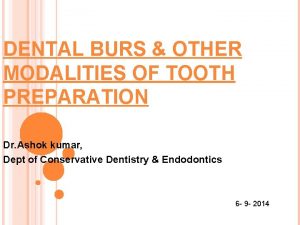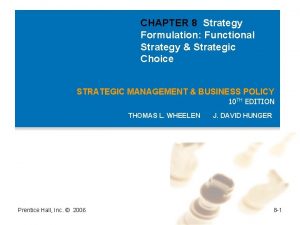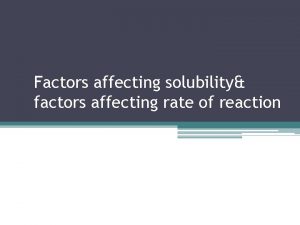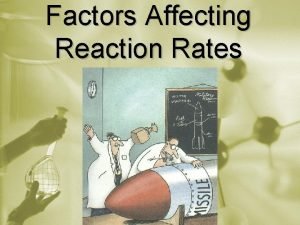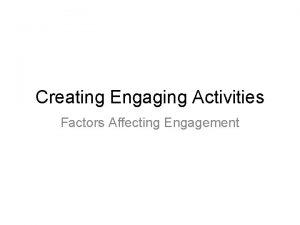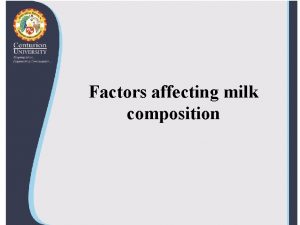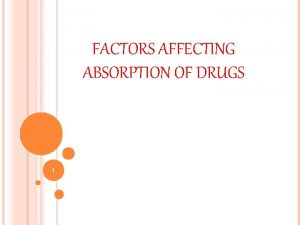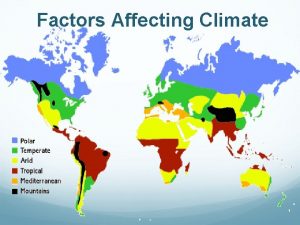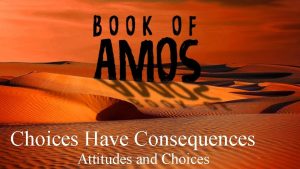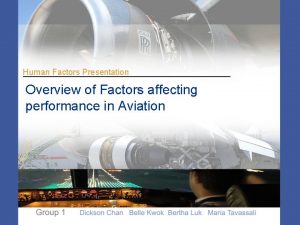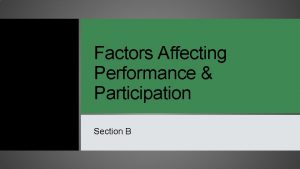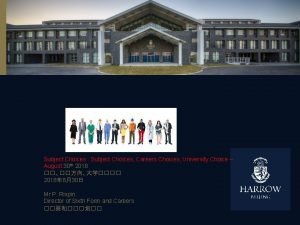Factors affecting academic performance and higher education choices









































































- Slides: 73

Factors affecting academic performance and higher education choices of students at a regional university in Oklahoma: A profile of traditional-age adult learners and their unique educational needs. Presented to SIEC-ISBE, July 2015, Krakow, Poland Dr. Dana Moore Gray and Dr. Mary A. Millikin Rogers State University, Oklahoma, USA

Agenda Introduction Problem statement Literature review Research questions Methodology Sample Findings Conclusions

Introduction U. S. public higher education faces severe challenges Funding cuts and financial aid requirements Increased competition from private and nonprofit institutions Growth of adult learners as percentage of student population Focus on accountability - retention and graduation To succeed, U. S. public higher education must understand its students/customers Understand who students are and what they need to succeed in every course, every term Affects marketing, recruiting, degree programs, curriculum design, scheduling, and retention “Marketing is the art of creating genuine customer value. It is the art of helping your customers become better off” (Kotler & Keller, 2011)

Problem statement Who are our students? What factors affect their academic performance and higher education choices? What number of RSU students are traditional age students but have adult responsibilities?

Literature review: Who are our students? Traditional learners • Recent high school graduates • Under age 25 • Few adult responsibilities other than school • Pedagogy New category? Traditional-age adult learners • Under age 25 • Adult responsibilities Adult learners • Over age 25 • Multiple adult roles and responsibilities • Growth driven by social and economic forces and technology advancements • Resulting growth in online courses, evening schedules, fast-track courses, etc. (Ross. Gordon, 2011) • Andragogy

Adult learners characteristics Nontraditional learners - adults beginning or continuing their enrollment as college students at a later-than-typical age (NCES, 2002) Now more broadly defined to include 7 characteristics not typically associated with participation in college. . . 73 percent of students may be viewed as nontraditional (Choy, 2002, 1). These characteristics include (Ross-Gordon, 2011) Has delaying entry to college by at least one year after high school May have dependents May be a single parent May be employed full time Is financially independent Attends school part time May not have a high school diploma

Literature review: Pedagogy – art, science, profession of teaching and learning (Merriam Webster, 2015) Primary methodology of education Historically designed for teaching children Universities traditionally use a pedagogical approach for traditional-age learners (defined under age 25 and recent high school graduates)

Literature review: Andragogy – theory and practice of teaching and learning of adults Malcolm Knowles (1978) popularized andragogy Defined adult learners as age 25 and older, have adult responsibilities that may include employment and dependents Identified unique characteristics of adult learners Principles of adult learners

Literature review: Andragogy, continued Due in: to focus on andragogy in recent decades, shift Teaching and learning strategies Scheduling of terms and courses Sequencing of courses Increased availability of certificate programs All to help the adult learners learn and retain more, pass courses, and achieve their higher education goals while balancing multiple adult demands.

Research Questions 1. Do regional universities have a segment of students age 25 and younger who meet the definition of adult learner? 2. Of those students age 25 and younger, how many must manage one or more adult responsibilities while going to school full time? 3. What are the motivational beliefs contributing to student success for this sub-population?

Methodology Mixed The methods convergent parallel design

About RSU Small regional university in northeastern Oklahoma in the U. S. Open enrollment – no admission requirements Main campus is located in small community surrounded by large rural areas 75% Two commuter at main campus satellite campuses in very small communities 100% commuter at branch campuses

About RSU Regional public university in northeastern Oklahoma in the U. S. Largely rural and small town population, low to medium economic status Total enrollment 4, 030 in fall 2014 3, 706 spring 2015

1. Does RSU have a segment of students age 25 and younger who meet the definition of adult learner?

Does RSU have a segment of students age 25 and younger who meet the definition of adult learner? Seven non-traditional indicators selected 1. Married 2. GED (General Education Development) 3. Independent of parents 4. Have dependent children or adults 5. Enrolled part-time 6. Working simultaneously to being enrolled 7. Single parent

Non-Traditional Student Indicators Three of seven indicators available from university Student Information System Three more indicators available from FAFSA information Only 50% of RSU students receive need-base financial aid. Half of RSU students do not submit a Free Application for Federal Student Aid (FAFSA). To identify majority of student indicators, researchers needed to asked students

Survey developed using literature review to identify indicators and motivational beliefs (57 items) Demographics: Prior 16 items indicators and motivational beliefs: 7 items Current college indicators: 16 items External Other college indicators: 10 items information: 8 items

Sample All 3, 706 students enrolled spring 2015 were eligible to participate A sample size of 349 students was targeted for this study, representing a 5% margin of error and 95% confidence level for all fulltime students enrolled at RSU during spring 2015 695 students completed the survey Student survey records were appended to indicator data from Student Information System

Sample Participation was voluntary Invitation to participate emailed to all enrolled students Link to online survey was posted on Learning Management System (LMS) home page Three $50 gift cards were used as an incentive Names were randomly selected from sample database during a Business Statistics class to demonstrate random sampling

Sample generalizability: Status Population Parttime; 33% Sample Parttime; 15% Fulltime; 67% Fulltime; 85%

Sample generalizability: Gender Population Male; 37% Sample Male; 24% Female, 63% Female, 76%

Sample generalizability: Race/Ethnicity All Others 10% Population Native American 30% Caucasian 60% All Others 7% Native American 25% Sample Caucasian 68% Native American includes those selecting Native American and second race

Sample generalizability: Degree-seeking Population Master's <1% Bachelor’s, 55% Sample Master's <1% Associate’s 27% Associate’s 43% Bachelor’s, 72%

Sample generalizability: Age 100% 90% >25 years 29, 20% 80% >25 years 41, 70% 60% 21 -25 years 29, 60% 50% 21 -25 years 29, 80% 40% 30% 20% <21 years 41, 20% <21 years 28, 10% 0% Population Pop mean = 23. 5 years; Median = 27 years Sample mean = 27. 6 years; Median = 23 years

Sample generalizability Strong response rate Somewhat underrepresented Part-time Male Associate <21 degree-seekers years Focus on under-represented students in future research Age may be indicative of traditionality Traditional survey students are <21 and less likely to respond to such a

1. Does RSU have a segment of students age 25 and younger who meet the definition of adult learner?

Selecting only the 58% of respondents who were age 25 or younger (n = 402) <21 years; 28% >25 years; 42% 21 -25 years; 30%

Number of non-traditional indicators for age 25 and younger: Seven indicators None 8% 1 21% 4 or More 48% 2 or 3 23% Proportion of students with 4, 5 or 6 indicators evenly distributed

2. Of those students age 25 and younger, how many must manage one or more adult responsibilities while going to school full time? Nearly ¼ had one indicator Nearly ¼ had two or three indicators Nearly ½ had four or more indicators

1. RSU has a significant segment of students age 25 and younger (58%) that meets the definition of adult learner. 2. 92% of this segment has one or more nontraditional indicators.

Indicator specificity by age group

Independent from parents 99, 2% 100% 90% 80% 70% 58, 0% 60% 50% 40% 30% 22, 4% 20% 10% 0% < 21 Years 21 - 25 Years > 25 Years

Work while enrolled 100% 85, 0% 90% 80% 76, 1% 70, 1% 60% 50% 40% 30% 20% 10% 0% < 21 Years 21 - 25 Years > 25 Years

Married 100% 90% 79, 4% 80% 70% 60% 50% 40% 30% 20, 9% 20% 10% 3, 6% 0% < 21 Years 21 - 25 Years > 25 Years

Have dependent(s) 100% 90% 80% 73, 9% 70% 60% 50% 40% 30% 20, 8% 20% 10% 6, 1% 0% < 21 Years 21 - 25 Years > 25 Years

Single parent 100% 90% 80% 70% 60% 50% 40% 30% 19, 2% 20% 10% 4, 1% 10, 1% 0% < 21 Years 21 - 25 Years > 25 Years

Enrolled part-time 100% 90% 80% 70% 60% 48, 8% 50% 40% 26, 1% 30% 20% 14, 1% 10% 0% < 21 Years 21 - 25 Years > 25 Years

GED General Education Development High School Equivalency Test 100% 90% 80% 70% 60% 50% 40% 30% 20% 10% 0% 0% < 21 Years 3, 4% 21 - 25 Years 8, 7% > 25 Years

3. What are the characteristics and motivational beliefs contributing to student success for this sub-population?

Academic preparation and current status RSU Population Mean RSU < 25 Years Mean ACT COMP 20. 5 22. 0 ACT English 20. 1 22. 4 ACT Math 19. 4 21. 0 ACT Reading 21. 9 23. 5 ACT Science 21. 1 22. 5 CUM GPA 2. 87 3. 06 CUM Hours 75. 2 56. 9 Earned

#18. AP and #19. Concurrent Advanced Placement In High School Concurrently Enrolled in High School Yes 40% No 41% Yes 59% No 60% Significantly higher than population average at 95% confidence level (Chi-square test)

Non-traditional learners 25 Years and younger were more academically prepared

Other current indicators

#8. What is your native or first language? First Language English Spanish Cherokee Hmong Korean Pfälzisch German Number of Respondents 384 9 3 3 2 1

#9 How many other colleges or universities have you attended? Two Colleges 8% Three Colleges 3% One College 32% #1 Other college was local community college No Other College 57%

#13. Academic classification Senior 20% Junior 27% Freshman 30% Sophomore 23%

#20. Coursework: Scheduling time 60, 0% 50, 0% More Effective Than Most 41, 6% As Effective As Most, 47. 8% 40, 0% 30, 0% Not As Effective As Most 10, 7% 20, 0% 10, 0% More Effective Than Most As Effective Than Most Not As Effective As Most

#20. Coursework: Monitoring time 60, 0% 50, 0% 40, 0% More Effective Than Most 35, 5% As Effective Than Most 55, 2% 30, 0% Not As Effective As Most 9, 3% 20, 0% 10, 0% More Effective Than Most As Effective Than Most Not As Effective As Most

#20. Coursework effectiveness: Study habits 60, 0% 50, 0% 40, 0% 30, 0% More Effective Than Most 29, 9% As Effective Than Most 53, 4% Not As Effective As Most 16, 7% 20, 0% 10, 0% More Effective Than Most As Effective Than Most Not As Effective As Most

#20. Coursework: Regulating or changing study habits As Effective Than Most 53, 4% 60, 0% 50, 0% 40, 0% 30, 0% More Effective Than Most 29, 9% Not As Effective As Most 16, 7% 20, 0% 10, 0% More Effective Than Most As Effective Than Most Not As Effective As Most

25 Years and younger non-traditionals report as effective or better study habits

#21. Working while enrolled 81% work 25 years and younger at RSU 70% work university-wide 45% work 25 years and younger nation-wide http: //www. aaup. org/article/understanding-working-college-student#. VZ 2 O 5 vl. Vikq

Average college student hours/week Course Load Study Out of Class Work Volunteer 80 70 Volunteer 3, 6 60 Hours Per Week Work 21, 8 50 Volunteer 3, 5 40 Work 19 30 Study Out of Class 31, 6 Study Out of Class 14, 4 20 10 Course Load 12, 5 Course Load 12 RSU Non-traditional < 25 National Average 0 http: //college. usatoday. com/2014/08/18/how-much-do-you-study-apparently-17 -hours-a-week-is-the-norm/ USA Today, August 18, 2014

RSU 25 years and younger non-traditional students are spending significantly more time studying than the national average.

Work schedules Do not Work <20 hours Work 20 - 34 hours Work > 35 hours 120% 100% Hours Per Week Work > 35 hours 27% 80% 60% Work > 35 hours 9% Work 20 - 34 hours 21% Work 20 - 34 hours 36% Work <20 hours 18% 40% Work <20 hours 18% 20% Do not Work 48% Do not Work 19% 0% RSU Non-traditional < 25 National <25 Years

Working to pay for educational expenses If you work for pay, do you do so in order to pay for educational expenses? 56% Yes If you work for pay, do you do so in order to pay for living expenses? 78% Ye 0% 10% 20% 30% 40% 50% 60% 70% 80% 90%

Study habits I effectively organize my time and schedule to provide time for my studies. Agree or Strongly Agree 77% I am careful not to allow work to interfere with my studying and class attendance. Agree Or Strongly Agree 74% 0% 10% 20% 30% 40% 50% 60% 70% 80% 90%

Reasons for working I need the money for basic essentials. 77% I find it useful to my college success to carefully organize my time and schedule. Agree or Strongly Agree Or Strongly Agree 93% 0% 10% 20% 30% 40% 50% 60% 70% 80% 90% 100%

Reasons for working I have no choice; my family cannot help me financially. Agree or Strongly Agree 49% I can't manage just on a student loan. Agree Or Strongly Agree 44% 0% 5% 10% 15% 20% 25% 30% 35% 40% 45% 50% 55%

Reasons for working I want to reduce the amount I borrow. Agree or Strongly Agree 61% Agree Or Strongly Agree I want the experience. 63% 0% 10% 20% 30% 40% 50% 60% 70%

Reasons for working My family encouraged me to take a job. Agree or Strongly Agree 44% I thought the work would help me get a job when I graduate. Agree Or Strongly Agree 49% 0% 5% 10% 15% 20% 25% 30% 35% 40% 45% 50% 55%

Reasons for working Agree or Strongly Agree To avoid taking out a student loan. 48% I wanted to buy a particular item (e. g. , car, etc. ) 39% 0% Agree Or Strongly Agree 5% 10% 15% 20% 25% 30% 35% 40% 45% 50% 55%

Significant factors in success for non-traditional adult learners Defining “success” as cumulative GPA Predictors of success at 90% confidence level for exploratory educational research Learners asked to rank most important responsibilities: Family, College, or Work #1 ranking of College responsibility resulted in highest GPA (not sig) #2 ranking of Family responsibility resulted in highest GPA (sig =. 05) #3 ranking of Work responsibility resulted in highest GPA (sig =. 01)

Significant factors in success for non-traditional adult learners Supportive family (sig =. 08) with “Uncertain” as only predictor of lower GPA (lower than “Not At All Supportive”) Transfer from RSU Before Graduation (sig =. 01) with “Uncertain” as only predictor of lower GPA (lower than “Very Likely to Transfer”) Likelihood to enroll in at least one face-to-face course in the coming year (sig =. 04) predicted higher GPA Intention to enroll in other course modalities was not significant Time of day for courses was not significant

Significant factors in success for non-traditional adult learners Supportive Family “Uncertain” is a red flag 1 st responsibility not significant (College slightly higher GPA than Family) 2 nd responsibility ranked as Family 3 rd responsibility ranked as Work Likely to graduate from RSU Likely to enroll

Predicting success for traditional age adult learners Average number of hours worked per week Number of Non-traditional Indicators Number of hours enrolled during semester First generation college status R =. 352; R 2 =. 124 (explaining 12. 4% of variance) Note: SPSS used to run all tests including t tests, Chi square tests, ANOVA, and regression analysis

There is much more that we need to learn about this new category of traditional-age adult learners.

Findings: Traditional-age adult learners Discovery of a third category of higher education student: the traditional-age adult learner. These are traditional-age college students who have adult responsibilities including dependent children, jobs requiring at least 20 hours of work per week, etc. Not accurate to only use age to identify learners as traditional or adult.

Findings: Traditional-age adult learners Tend to be more academically prepared Tend to report stronger study habits 17 8 hours per week more study time than national average out of 10 work for pay 20 -30 To 82% hours is the median work week pay for living expenses report families are somewhat to highly supportive

Findings: Traditional-age adult learners Will prioritize work responsibilities after family and college responsibilities Are more certain or confident about their choices Determining to graduate at RSU or transfer out Understanding Manage whether or not their families are supportive the number of hours they work and the number of hours in which they enroll

Conclusions Faculty with traditional-age adult learners may implement more andragogic approaches to teaching and learning, curriculum design, and interaction/engagement. University may develop more programmatic responses (Ross. Gordon, 2011) Degree and certificate programs flexible in time and location Broader access to key student services Distance education Prior learning assessment including advanced placement, CLEP tests, and portfolio evaluation (Klein-Collins & Hein, 2009) Accelerated course formats More research, including subpopulations of adult learners

“Who should ultimately design the product? The customer, of course. ” - Philip Kotler http: //www. slideshare. net/bright 9977/16 -quotes-about-your-customer

References Choy, S. (2002). Findings from the condition of education 2002: Nontraditional undergraduates. Washington, DC: National Center for Education Statistics. Klein-Collins, B. , & Hein, P. (2009). “Prior learning assessment: How institutions use portfolio assessments. ” The Journal of Continuing Higher Education 57: 187– 189. Knowles, M. (1984). Andragogy in action. San Francisco: Jossey-Bass. Kotler, P. , & Keller, K. L. (2011). Marketing management, 14 th ed. United States: Prentice Hall. Merriam Webster (2015). Definition of pedagogy. Retrieved June 21, 2015 from http: //www. merriamwebster. com/dictionary/pedagogy. National Center for Education Statistics (2002). Digest of Educational Statistics 2009. Table 192. Total fall enrollment in degreegranting institutions by control and type of institution, age, and attendance status of student: 2007). http: //nces. ed. gov/programs/digest/d 09/tables/dt 09_192. asp? referrer=list Perna, L. W. (2010, July-August). Understanding the working college student. Academe. Retrieved July 13, 2015 from http: //www. aaup. org/article/understanding-working-college-student#. VZ 2 O 5 vl. Vikq Pierre, K. (2014, August 18). How much do you study? Apparently 17 hours a week is the norm. USA Today. Retrieved July 13, 2015 from http: //college. usatoday. com/2014/08/18/how-much-do-you-study-apparently-17 -hours-a-week-is-the-norm/ Rocco, T. (2001). “Helping Adult Educators Understand Disability Disclosure. ” Adult Learning 12 (2): 10– 12. Ross-Gordon, J. M. (2011). Research on adult learners: Supporting the needs of a student population that Is no longer nontraditional. AACU. Retrieved June 22, 2015 from https: //www. aacu. org/publications-research/periodicals/research-adult-learners-supportingneeds-student-population-no Ross-Gordon, J. M. (2005). “The adult learner of color: An overlooked college student population. ” The Journal of Continuing Higher Education 53 (2): 2– 11. Rumann, C. B. , * Hamrick, F. A. (2010). “Student Veterans in Transition: Re-Enrolling after War Zone Deployments. ” Journal of Higher Education 81: 431– 458. Yusoontorn, S. (2011). 16 Quotes from Philip Kotler. Slideshare. Retrieved June 15, 2015 from http: //www. slideshare. net/bright 9977/16 -quotes-about-your-customer.
 Five factors that affect housing choices
Five factors that affect housing choices Collaborative on academic careers in higher education
Collaborative on academic careers in higher education Factors that affect sports performance
Factors that affect sports performance Physical factors affecting sports performance
Physical factors affecting sports performance Internally paced skill examples
Internally paced skill examples Factors affecting performance of parallel algorithm
Factors affecting performance of parallel algorithm Factors affecting performance
Factors affecting performance Hollander 1967 model of personality
Hollander 1967 model of personality Factors affecting movement in physical education
Factors affecting movement in physical education Factors affecting the communication process
Factors affecting the communication process Factors that affect your food choices
Factors that affect your food choices Factors affecting wound healing local and systemic
Factors affecting wound healing local and systemic Lifestyle factors affecting oxygenation
Lifestyle factors affecting oxygenation Factors affecting width and intensity of spectral lines
Factors affecting width and intensity of spectral lines Factors affecting solvation energy
Factors affecting solvation energy Objectives of wage and salary administration
Objectives of wage and salary administration Factors affecting mobility and immobility
Factors affecting mobility and immobility Test retest reliability
Test retest reliability Factors affecting their climate
Factors affecting their climate Factors affecting microbial growth in food
Factors affecting microbial growth in food Factors affecting magma viscosity
Factors affecting magma viscosity Factors affecting volcanic eruption
Factors affecting volcanic eruption Nozzle lip is provided in simple carburettor
Nozzle lip is provided in simple carburettor Applications of tga
Applications of tga Factors of bilingualism
Factors of bilingualism Human movement impact factor
Human movement impact factor Preload stroke volume
Preload stroke volume Baricity of local anesthetics
Baricity of local anesthetics Eluviation vs illuviation
Eluviation vs illuviation Factors affecting health
Factors affecting health Section 17.2 factors affecting chemical equilibrium
Section 17.2 factors affecting chemical equilibrium Factors affecting sample size
Factors affecting sample size What is merchandising
What is merchandising Factors affecting planning in sports management
Factors affecting planning in sports management Factors affecting rate of cooling
Factors affecting rate of cooling First pass effect in pharmacology
First pass effect in pharmacology Factors regulating cardiac output
Factors regulating cardiac output Factors affecting transportation decisions
Factors affecting transportation decisions Factors affecting span of control
Factors affecting span of control Semianatomic
Semianatomic Factors affecting bacterial growth in microbiology ppt
Factors affecting bacterial growth in microbiology ppt Functional departmentalization groups jobs by
Functional departmentalization groups jobs by Rohwers formula
Rohwers formula Factors affecting milling process
Factors affecting milling process Lush
Lush Factors affecting enzyme activity bbc bitesize
Factors affecting enzyme activity bbc bitesize Factors effecting gfr
Factors effecting gfr What factors affect optimum weight
What factors affect optimum weight Factors affecting fermentation
Factors affecting fermentation Factors affecting fermentation
Factors affecting fermentation Angle of repose in pharmacy
Angle of repose in pharmacy Interior design factors
Interior design factors Factors affecting interior design
Factors affecting interior design Factors affecting the rate of chemical reaction temperature
Factors affecting the rate of chemical reaction temperature A factor that affects the flight of a projectile
A factor that affects the flight of a projectile Factors affecting population explosion
Factors affecting population explosion Factors affecting organizational design
Factors affecting organizational design Factors affecting option pricing
Factors affecting option pricing What are the factors affecting motion
What are the factors affecting motion Factors affecting bacteria growth
Factors affecting bacteria growth Factors affecting interpersonal skills
Factors affecting interpersonal skills Social factors affecting human resource management
Social factors affecting human resource management Definition of le chatelier's principle
Definition of le chatelier's principle Milk powder bulk density
Milk powder bulk density Ph partition theory of drug absorption
Ph partition theory of drug absorption Plant layout concepts
Plant layout concepts Esp
Esp Factors affecting entrepreneurial growth
Factors affecting entrepreneurial growth Different social factors
Different social factors Types of burs used in operative dentistry
Types of burs used in operative dentistry Fringed micelle model
Fringed micelle model Factors influencing consensus
Factors influencing consensus Manegerial functions
Manegerial functions Functional strategy and strategic choice
Functional strategy and strategic choice

